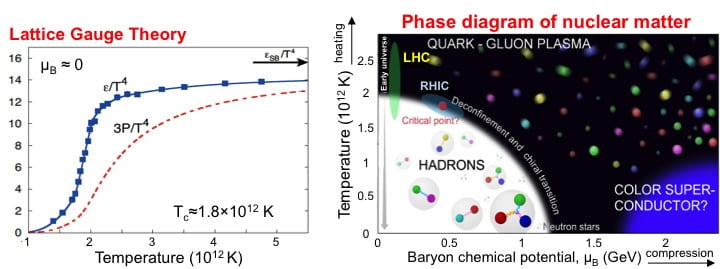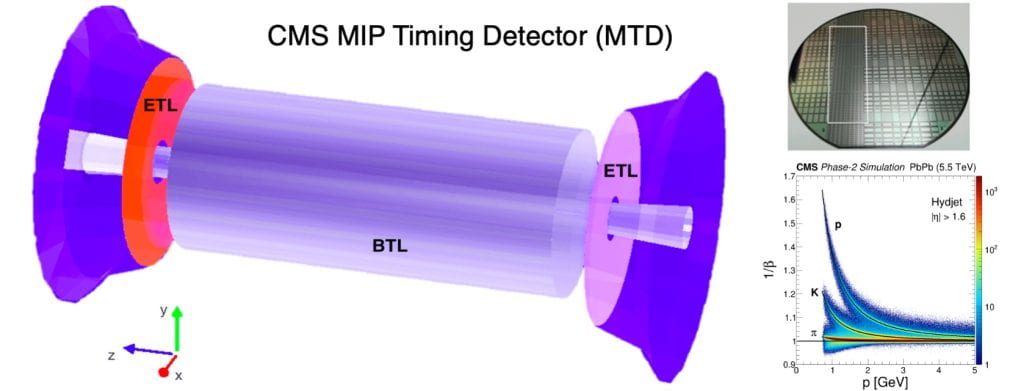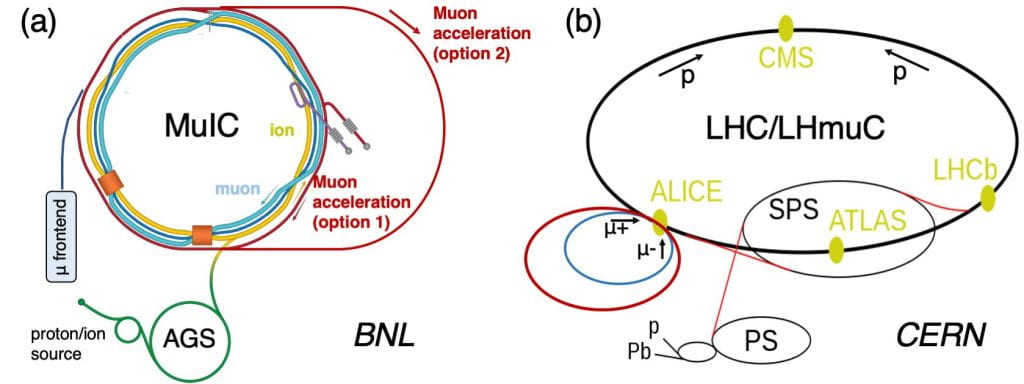QCD vacuum and collective phenomena at extreme scales
Our research interests, in broad terms, focus on the experimental investigation of the behavior of nuclear matter under extreme conditions of high temperature and/or energy density.
Nuclei are the cores of atoms that make up about 99.99% of the atomic mass. A nucleus is made up of protons and neutrons (called nucleons), which determine its element and isotope. However, nucleons are not the most basic constituents of nuclei. Each nucleon consists of quarks and gluons, which are bounded together by the strong nuclear force, one of the four fundamental interactions of nature. The strong force is described by the theory of Quantum Chromodynamics (QCD) and has the peculiar feature that quarks and gluons interact strongly when they are far removed, called confinement, but appear to be almost free when approaching each other, known as asymptotic freedom. This leads to a rich structure of the phase diagram for matter governed by QCD processes. Lattice QCD calculations predict that a crossover to a new phase of QCD matter will occur at high temperatures around 170 MeV (~ 2 x 1012 kelvins), in which quarks and gluons appear to be deconfined (see picture below). This so-called Quark-Gluon Plasma (QGP) is believed to have existed in the first few microseconds after the Big Bang.

To recreate a “little Big Bang” in the laboratory, accelerator technology was applied to circulate two heavy-element nuclei at nearly the speed of light in the opposite directions so that the nuclei collide head-on. As illustrated below, fast-moving Pb nuclei are initially compressed into a pancake shape due to the Lorentz contraction. Shortly after the reaction (~ 1 fm/c), an enormous amount of energy is released into a tiny volume (~ 10 fm in diameter) wherein a QGP medium may possibly form. The QGP will expand and cool down rapidly. Once its temperature falls below Tc, bound states of quarks and gluons will form, a process called hadronization. The lifetime of the tiny QGP last for about 10 fm/c. Finally, experimental detectors placed around the reaction point will capture the hadronized particles from QGP and reconstruct their trajectories to trace back relevant information during the course of collision.

In the past 15 years, the Relativistic Heavy Ion Collider (RHIC) at the Brookhaven National Laboratory (BNL), NY, has made major breakthroughs in discovering a new state of nuclear matter with a temperature of 300-400 MeV in collisions of two gold nuclei, which is postulated to be the QGP. In 2010, with the onset of the Large Hadron Collider (LHC) at CERN, the field of relativistic heavy ion physics has undergone a “COBE-to-WMAP” transition, toward a more precise understanding of the properties of QGP. Our group is participating in the Compact Muon Solenoid (CMS) experiment, one of the four experiments built at the LHC. Featured by a very broad acceptance coverage, and precise particle tracking and calorimeter, the CMS detector is ideally suited to explore the physics of QGP. A beautiful picture of the LHC at CERN, and a schematic of the CMS detector is shown below.

Most strikingly, the hot QGP matter was found to be strongly interacting, behaving like a liquid, instead of a weakly interacting gas, as was originally proposed. This QGP liquid flows better than any known form of matter with almost no frictional resistance or viscosity. The main evidence leading to the discovery of this perfect QGP liquid was acquired in the study of particle azimuthal angular distribution (φ). Because heavy nuclei are compound objects, the size and shape of the collision region depend on the distance between the centers of the nuclei at impact (i.e., the impact parameter). The created medium in the overlap region has an asymmetry in transverse x-y coordinate space. For a liquid-like medium, strong rescattering of quarks and gluons may lead to local thermal equilibrium and the build-up of anisotropic pressure gradients, which drive a collective anisotropic expansion. The expansion is fastest along the largest pressure gradient, i.e., along the short axis of the almond-shaped volume. As a result, constituents emitted from the medium will naturally reflect this azimuthal asymmetry in their momentum space. This anisotropy is typically characterized by the second Fourier coefficient (v2), known as the “Elliptic Flow”, in particle azimuthal distribution, dN/d(φ- Ψ2) ~ 1+2 v2 cos[2(φ-Ψ2)], where Ψ2 is the impact parameter direction. An example of φ distribution can be seen in the figure below which exhibits a clear cos(2φ) pattern. A flat distribution would have been seen if QGP was a weakly interacting gas.

It was previously thought that the formation of the QGP liquid is only possible in heavy ion (AA) collisions where the sufficiently large system size and long lifetime allow thermalization to occur. In systems like proton-proton (pp) and proton-ion (pA) collisions, the initial collision zone is about an order of magnitude smaller in size than in AA, and it was, therefore, not anticipated that a QGP liquid state could be formed there. However, shortly after the LHC startup in 2010, a novel long-range, near-side ( Δφ ~ 0) two-particle correlation was observed, led by Prof. Li, in very high-multiplicity (number of final-state particles) pp collisions with the CMS experiment at the LHC. The unexpected finding consists of a novel correlation in which particles coming out of the collision are aligned in their azimuthal angles (Δφ) over a wide pseudorapidity (η) region, a “ridge”-like structure, as shown below (left). This correlation is absent in typical pp events but emerges as particle multiplicities reach very high values. Subsequently, our group led the analysis of first proton-lead (pPb) collision data at the LHC in 2012, which again revealed a surprisingly strong long-range ridge correlation for high-multiplicity pPb events (middle). This phenomenon is reminiscent of the long-range correlation first seen in AA collisions (right).

To quantify the properties of hot QGP medium and elucidate its mysterious nature of perfect fluidity using the technique of particle correlations are the central themes of our current and future research efforts. In particular, to understand the origin of novel ridge correlations in high multiplicity pp and pPb collisions is currently a focal interest in the community, where our group is playing a leading role. With new opportunities emerging from future LHC runs and upgraded CMS detector, we are entering an exciting era in the study of hot QGP matter.
Probing ultra-dense gluonic matter with high energy photons
The Lorentz-boosted electromagnetic (EM) fields surrounding relativistic heavy ions with large charges can be treated as a flux of quasireal photons with the flux intensity proportional to the square of the ion charge. Therefore, ions accelerated at colliders can interact when their impact parameter (b) is greater than twice the nuclear radius (RA), via photon-photon and photon-nucleus processes, the so-called ultraperipheral collisions (UPCs). Photon-photon interactions can be used to test quantum electrodynamics (QED) and to search for physics beyond the standard model. Photon-nucleus interactions probe the gluon distribution at small Bjorken x in the nucleon or nucleus.

The UPCs can occur in conjunction with the excitation of one or both of the ions via photon absorption into giant dipole resonances or higher excited states, which typically decay by emitting a single or more neutrons. These forward neutrons travel at nearly zero degrees with respect to the beam pile and can be detected by the zero degree calorimeters. The probability of neutron emissions is strongly correlated with the interaction impact parameter. Therefore, we can use the forward neutron activity as a lever-arm to control the impact parameter of ultra-peripheral collisions. Our group has pioneered the application of this technique in photon-photon and photon-nucleus processes and is carrying out a comprehensive program of studying the strong field QED and probing emergent behavior of high density gluons inside heavy nuclei.
Over the next decade, a new collider – the Electron-Ion Collider – will be constructed at the Brookhaven National Lab, which will provide a high precision electron microscope to image the nucleon and nucleus. Our group is an active member of the ePIC collaboration.
Ultra-fast silicon sensors and high-speed electronics at the LHC and EIC
The high-luminosity Large Hadron Collider (HL-LHC), scheduled to come into operation at the end of 2027, will bring the fields of high energy particle and nuclear physics to an unexplored, high-precision frontier. The CMS detector will undergo a series of major “Phase-2” upgrades to most of its subsystems. In particular, a MIP Timing Detector (MTD), with a design time resolution of ~30 ps and a hermetic coverage over |η|<3, will enable TOF-particle identification capabilities for the first time at CMS and provide a truly general purpose detector for the most comprehensive understanding of quark-gluon plasma (QGP).

The MTD design consists of a barrel timing layer (BTL) and an endcap timing layer (ETL), covering |η|<1.5 and 1.6<|η|<3, respectively. LYSO crystal scintillators read out with silicon photomultipliers have been chosen as a mature technology for the barrel timing layers. Low Gain Avalanche Diodes (LGADs) with internal gain is a novel fast-timing silicon sensor, and is chosen as the technology for the endcap timing layers. The US CMS heavy ion physics groups will be responsible for 50% of the ETL construction, under the leadership of the Rice University group. Besides the project management, our group is responsible for the development and production of ETL readout service hybrids and power system.

The ultra-fast silicon sensor technology represents the technology for future high precision tracking system providing both position and timing information. Leveraging on expertise in the CMS MTD project, our group is also a main proponent of the time-of-flight system, based on the LGADs, for the ePIC experiment at the future electron-ion collider.
Muon-Ion Collider – the ultimate QCD frontier
Lepton-hadron (nucleus) deep inelastic scattering (DIS) has been a powerful tool to understand the fundamental structure of nucleons and nuclei. While the EIC will establish a new QCD frontier to address key open questions such as the origin of nucleon spin, mass, and the emergence of QCD phenomena at extreme parton densities with polarized beams at a center-of-mass energy up to 140 GeV, it is not the end of our quest in understanding all mysteries of the visible matter in the universe. A high-luminosity DIS collider in the TeV regime will be the ultimate dream to enter into a truly unexplored regime of QCD with great potential for new discoveries.

We have proposed a concept to achieve the next-generation TeV-scale DIS machine with a smaller footprint by replacing the electron beam of EIC by a muon beam and converting it into a muon-proton and muon-nucleus facility at BNL, referred to as a “muon-ion collider” (MuIC) (more details in NIM A 1027 (2022) 166334, arXiv:2203.06258). A muon beam energy up to about 960~GeV can be achieved with the EIC tunnel assuming dipole bending magnets of 11 T (planned for the HL-LHC). Such a facility would utilize the existing hadron accelerator infrastructure at BNL (as an “upgrade” to the EIC), while leveraging the development of a high energy and high intensity muon storage ring at the same site. A TeV-scale MuIC will bring us deeply into the non-linear QCD regime at small x, and unambiguously discover novel phenomena such as gluon saturation. Moreover, the MuIC will also serve as a scientific target for a demonstrator of muon collider technology toward the ultimate development of a multi-TeV muon-antimuon collider.

Re-using the established facility and evolving it into a new one has been a recipe of success in the history of US nuclear physics research, as it helps significantly reduce the project cost. For example, the RHIC was built in the ISABELLE tunnel after it was canceled in 1983, and the EIC was made possible because of the existence of RHIC. This is an approach the US nuclear and particle physics community should continue exploring for its future programs. Our group has been carrying out studies of physics potential and performance under a large beam induced background due to muon decays, to drive the future detector R&D direction. We encourage younger generation scientists to join us and make a bright future to the field.


